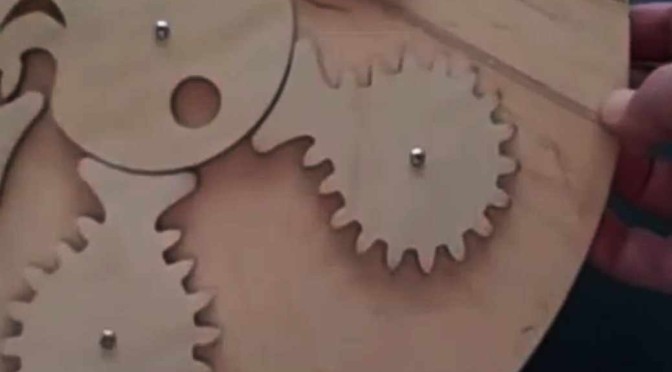Almost everything that has something spinning, probably has, one or a system of gears hidden inside it. Open up a CD drive, or anything that spins, and you’ll see. Mechanical engineers spend a good amount of time learning about traditional gear systems in their courses. I’ve compiled a few gear videos here, that are probably not covered in any educational institution’s syllabus. (please inform me in the comments section if you have them in your course)
1. Crazy shapes: While, It is popularly believed that gears have to be circular to work properly, it should be noted that gears can literally bear any shape and work fine, as long as they are designed well. In the following video we can see how carefully designed gears in square, oval, spiral, fish shapes, and any other out of the ordinary shapes, can be made to work together perfectly. [video]
Some other artistic wooden gear sculpture can be seen in the link here. Engineering meets art [Here]
Build at home: Turns out, with computers in every home these days, designing these gears isn’t rocket science. Enterprising engineers can use this fairly detailed 5-minute video tutorial to cut out weird gear shapes at home. The process of designing can be automated by using jerry’s script. [video]
2. Unpredictable moves – Gears can sometimes work together to provide a mechanical advantage in a system and can end up moving in a pretty unpredictable manner. The following video is a perfect example of how gear ratios can mess with the heads of non-engineers. The guy calls his machine – under the ruler faster than the ruler – watch it and you’ll understand why. [video]
It isn’t magic. If it still confuses you, here is a great post that explains a similar phenomenon that uses gears to build a “faster than wind cart (DDWFTW)“.
3. Reduction gear system with a fixed gear in the end: I wanted to keep this craziest reduction gear system for the end. It is the one that blew my mind. And the ones who think the number 1 and number 2 are ordinary systems they meet everyday in the lab, they need to check this one out.
This system designed by Arthur Ganson transcends engineering and moves into the realm of art. It consists of a motor that spins at 212 revs per minute. To the motor are attached twelve 50-1 reduction gears in series.
The most incredible part – the last gear in this series appears as if it is fixed, but it actually turns. It moves so slow, that it has been sealed into the wall using concrete. Even when the motor is turned on, it appears fixed with rest of the system moving continuously. It is estimated that if it wasn’t fixed, the gear would have taken 2 trillion years to make a complete revolution. In fact the third and the gears after that in this system don’t appear to be moving too.

